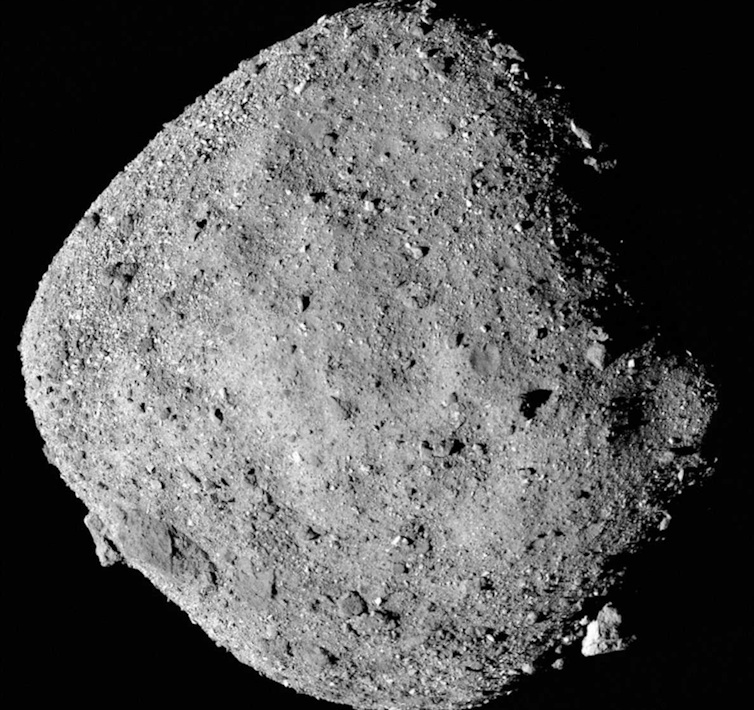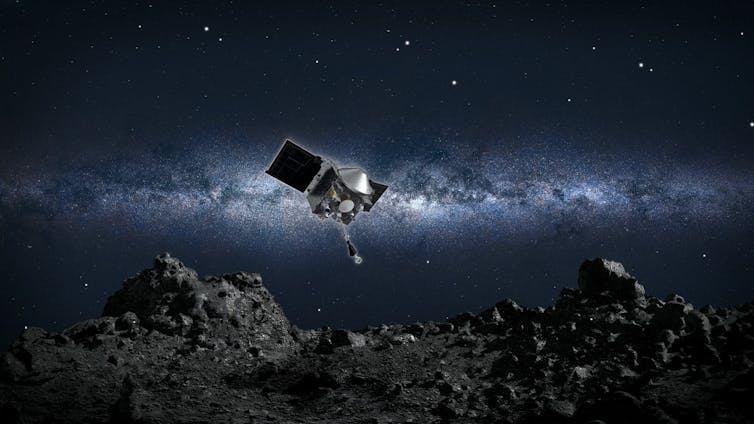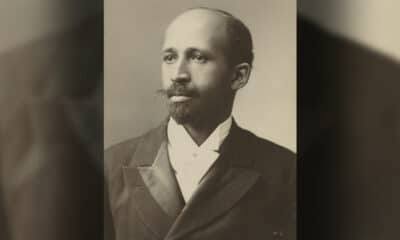
NASA
Timothy J McCoy, Smithsonian Institution and Sara Russell, Natural History Museum
A bright fireball streaked across the sky above mountains, glaciers and spruce forest near the town of Revelstoke in British Columbia, Canada, on the evening of March 31, 1965. Fragments of this meteorite, discovered by beaver trappers, fell over a lake. A layer of ice saved them from the depths and allowed scientists a peek into the birth of the solar system.
Nearly 60 years later, NASA’s OSIRIS-REx mission returned from space with a sample of an asteroid named Bennu, similar to the one that rained rocks over Revelstoke. Our research team has published a chemical analysis of those samples, providing insight into how some of the ingredients for life may have first arrived on Earth.
Born in the years bracketing the Revelstoke meteorite’s fall, the two of us have spent our careers in the meteorite collections of the Smithsonian Institution in Washington, D.C., and the Natural History Museum in London. We’ve dreamed of studying samples from a Revelstoke-like asteroid collected by a spacecraft.
Then, nearly two decades ago, we began turning those dreams into reality. We joined NASA’s OSIRIS-REx mission team, which aimed to send a spacecraft to collect and return an asteroid sample to Earth. After those samples arrived on Sept. 24, 2023, we got to dive into a tale of rock, ice and water that hints at how life could have formed on Earth.

NASA/Goddard/University of Arizona
The CI chondrites and asteroid Bennu
To learn about an asteroid – a rocky or metallic object in orbit around the Sun – we started with a study of meteorites.
Asteroids like Bennu are rocky or metallic objects in orbit around the Sun. Meteorites are the pieces of asteroids and other natural extraterrestrial objects that survive the fiery plunge to the Earth’s surface.
We really wanted to study an asteroid similar to a set of meteorites called chondrites, whose components formed in a cloud of gas and dust at the dawn of the solar system billions of years ago.
The Revelstoke meteorite is in a group called CI chondrites. Laboratory-measured compositions of CI chondrites are essentially identical, minus hydrogen and helium, to the composition of elements carried by convection from the interior of the Sun and measured in the outermost layer of the Sun. Since their components formed billions of years ago, they’re like chemically unchanged time capsules for the early solar system.
So, geologists use the chemical compositions of CI chondrites as the ultimate reference standard for geochemistry. They can compare the compositions of everything from other chondrites to Earth rocks. Any differences from the CI chondrite composition would have happened through the same processes that formed asteroids and planets.
CI chondrites are rich in clay and formed when ice melted in an ancient asteroid, altering the rock. They are also rich in prebiotic organic molecules. Some of these types of molecules are the building blocks for life.
This combination of rock, water and organics is one reason OSIRIS-REx chose to sample the organic-rich asteroid Bennu, where water and organic compounds essential to the origin of life could be found.
Evaporites − the legacy of an ancient brine
Ever since the Bennu samples returned to Earth on Sept. 24, 2023, we and our colleagues on four continents have spent hundreds of hours studying them.
The instruments on the OSIRIS-REx spacecraft made observations of reflected light that revealed the most abundant minerals and organics when it was near asteroid Bennu. Our analyses in the laboratory found that the compositions of these samples lined up with those observations.
The samples are mostly water-rich clay, with sulfide, carbonate and iron oxide minerals. These are the same minerals found in CI chondrites like Revelstoke. The discovery of rare minerals within the Bennu samples, however, surprised both of us. Despite our decades of experience studying meteorites, we have never seen many of these minerals.
We found minerals dominated by sodium, including carbonates, sulfates, chlorides and fluorides, as well as potassium chloride and magnesium phosphate. These minerals don’t form just when water and rock react. They form when water evaporates.
We’ve never seen most of these sodium-rich minerals in meteorites, but they’re sometimes found in dried-up lake beds on Earth, like Searles Lake in California.
Bennu’s rocks formed 4.5 billion years ago on a larger parent asteroid. That asteroid was wet and muddy. Under the surface, pockets of water perhaps only a few feet across were evaporating, leaving the evaporite minerals we found in the sample. That same evaporation process also formed the ancient lake beds we’ve seen these minerals in on Earth.
Bennu’s parent asteroid likely broke apart 1 to 2 billion years ago, and some of the fragments came together to form the rubble pile we know as Bennu.
These minerals are also found on icy bodies in the outer solar system. Bright deposits on the dwarf planet Ceres, the largest body in the asteroid belt, contain sodium carbonate. The Cassini mission measured the same mineral in plumes on Saturn’s moon Enceladus.
We also learned that these minerals, formed when water evaporates, disappear when exposed to water once again – even with the tiny amount of water found in air. After studying some of the Bennu samples and their minerals, researchers stored the samples in air. That’s what we do with meteorites.
Unfortunately, we lost these minerals as moisture in the air on Earth caused them to dissolve. But that explains why we can’t find these minerals in meteorites that have been on Earth for decades to centuries.
Fortunately, most of the samples have been stored and transported in nitrogen, protected from traces of water in the air.
Until scientists were able to conduct a controlled sample return with a spacecraft and carefully curate and store the samples in nitrogen, we had never seen this set of minerals in a meteorite.
An unexpected discovery
Before returning the samples, the OSIRIS-REx spacecraft spent over two years making observations around Bennu. From that two years of work, researchers learned that the surface of the asteroid is covered in rocky boulders.
We could see that the asteroid is rich in carbon and water-bearing clays, and we saw veins of white carbonate a few feet long deposited by ancient liquid water. But what we couldn’t see from these observations were the rarer minerals.
We used an array of techniques to go through the returned sample one tiny grain at a time. These included CT scanning, electron microscopy and X-ray diffraction, each of which allowed us to look at the rock at a scale not possible on the asteroid.
Cooking up the ingredients for life
From the salts we identified, we could infer the composition of the briny water from which they formed and see how it changed over time, becoming more sodium-rich.
This briny water would have been an ideal place for new chemical reactions to take place and for organic molecules to form.
While our team characterized salts, our organic chemist colleagues were busy identifying the carbon-based molecules present in Bennu. They found unexpectedly high levels of ammonia, an essential building block of the amino acids that form proteins in living matter. They also found all five of the nucleobases that make up part of DNA and RNA.
Based on these results, we’d venture to guess that these briny pods of fluid would have been the perfect environments for increasingly complicated organic molecules to form, such as the kinds that make up life on Earth.
When asteroids like Bennu hit the young Earth, they could have provided a complete package of complex molecules and the ingredients essential to life, such as water, phosphate and ammonia. Together, these components could have seeded Earth’s initially barren landscape to produce a habitable world.
Without this early bombardment, perhaps when the pieces of the Revelstoke meteorite landed several billion years later, these fragments from outer space would not have arrived into a landscape punctuated with glaciers and trees.![]()
Timothy J McCoy, Supervisory Research Geologist, Smithsonian Institution and Sara Russell, Professor of Planetary Sciences, Natural History Museum
This article is republished from The Conversation under a Creative Commons license. Read the original article.




























































